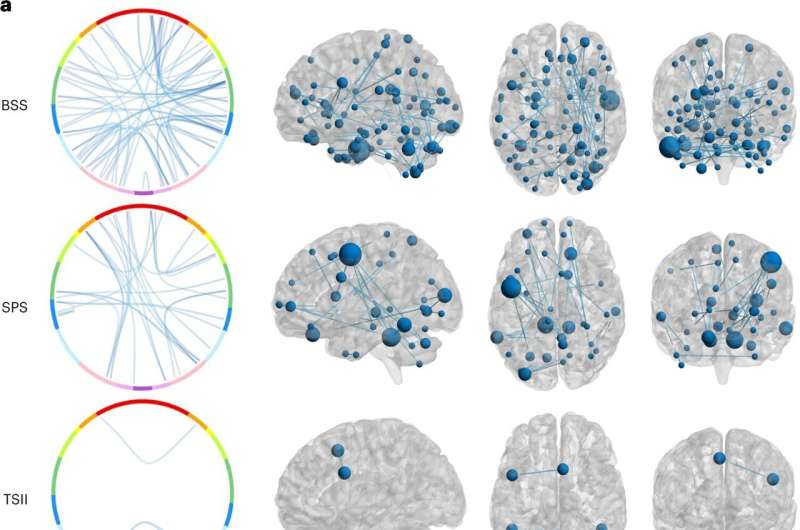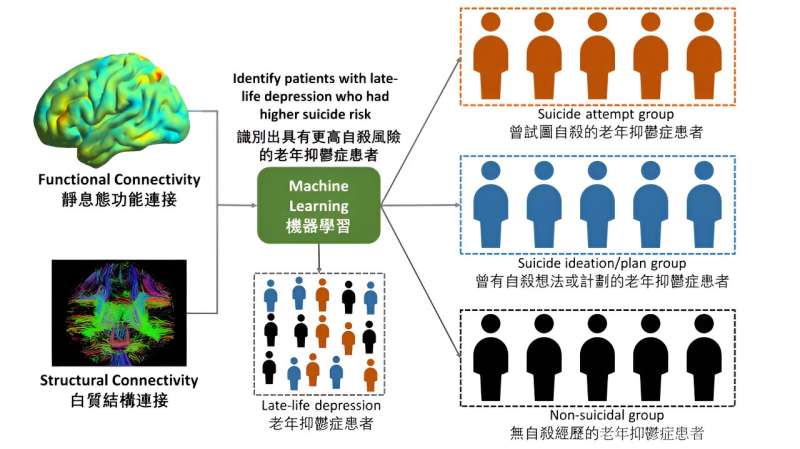This article has been reviewed according to Science X's editorial process and policies. Editors have highlighted the following attributes while ensuring the content's credibility:
fact-checked
peer-reviewed publication
trusted source
proofread
Study reveals brain connectivity patterns can predict suicide risk in patients with late-life depression

Suicidal ideation, plans and behaviors are serious health threats among older adults with late-life depression, resulting in a higher likelihood of death than in any other age group. The increasing prevalence of depression in late life speaks for the urgent need for cost-effective, objective screening of suicide risk.
The current screening for suicide risk primarily relies on structured clinical interviews and questionnaires, which are typically time-consuming and require effort to complete.
A study led by Professor Tatia Lee, Director of the State Key Laboratory of Brain and Cognitive Sciences of the University of Hong Kong (HKU), revealed that brain patterns could predict suicide risk in the late-life depression population. The findings have been published in Nature Mental Health.
Professor Lee's research team utilized connectome-based predictive modeling with whole-brain resting-state functional connectivity (i.e., significantly correlated brain signals between functionally related brain regions in the absence of any stimulus or task) and white matter structural connectivity (i.e., white matter fiber tracts physically interconnecting brain regions) data to predict suicide risk. These two techniques consistently show high test–retest reliability and generalizability across study contexts.
The study recruited 91 hospital patients diagnosed with major depressive disorder, including 37 non-suicidal patients, 24 patients with suicidal ideation/plan, and 30 patients who attempted suicide. Brain connectivity profiles were used to classify three groups in the dataset and two independent datasets using machine learning. The functional and structural connectivity profiles improved classification-prediction accuracy compared with using questionnaire scores alone and could be applied to identify depressed patients who had higher suicide risk in two independent datasets.

"Suicide is the worst outcome for people with depression, haunting those who suffered the loss. We are competing with time. The earlier we can tally the risk, the sooner life-saving intervention can be in place," Professor Lee said.
The research team highlighted that classification accuracy in distinguishing late-life depression patients with higher suicide risk from those with lower suicide risk was enhanced by considering functional and structural connectivity. They also suggested that multimodal brain connectivity could capture individual differences in suicide risk among late-life depression patients. The predictive models developed by the research team will be further tested for accurate screening for patients who need detailed assessments and interventions.
In future clinical assessments, the research team hopes to collect multimodal brain imaging, psychological, and behavioral data and integrate these data into predictive models to generate precision suicide risk scores, facilitating the design of individualized assessment and intervention programs.
More information: Mengxia Gao et al, Multimodal brain connectome-based prediction of suicide risk in people with late-life depression, Nature Mental Health (2023). DOI: 10.1038/s44220-022-00007-7




















